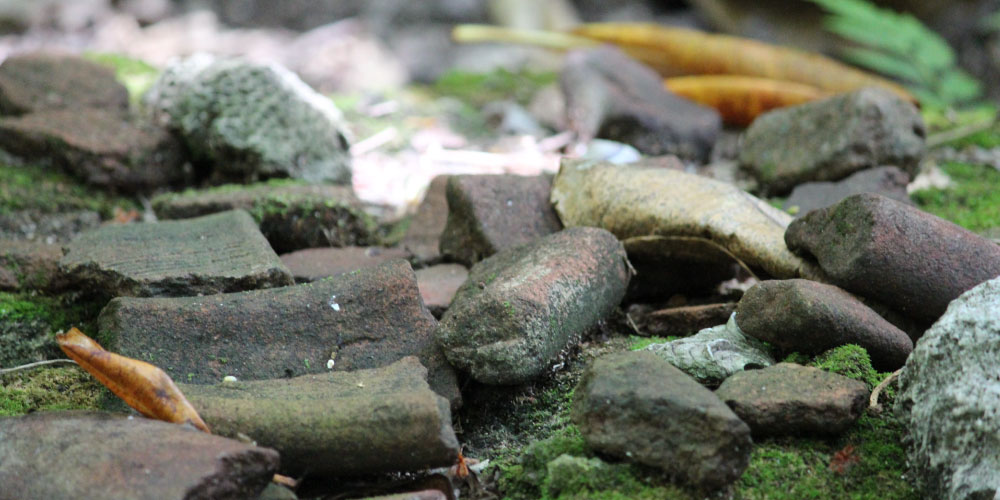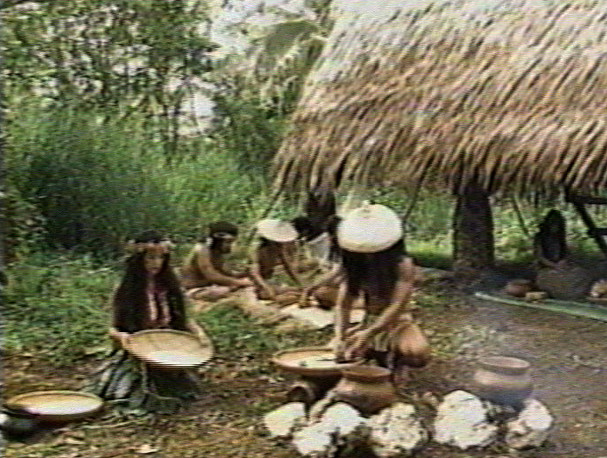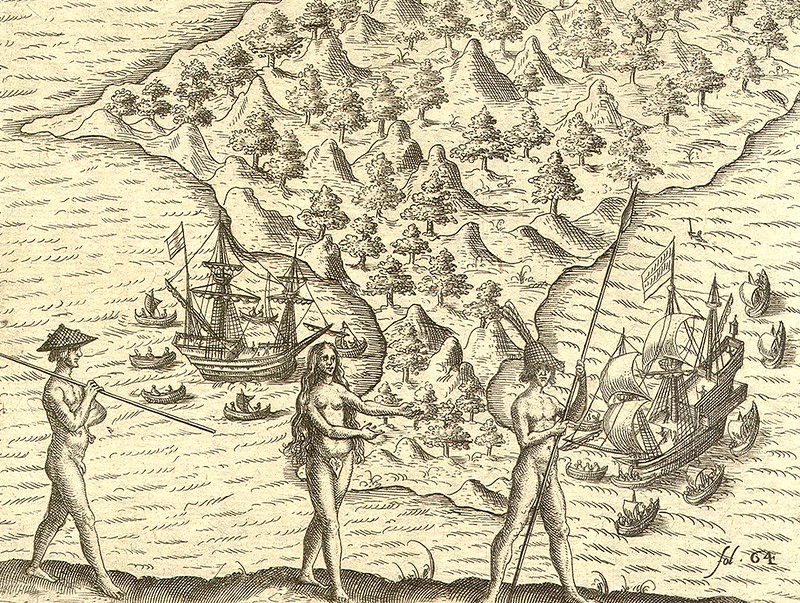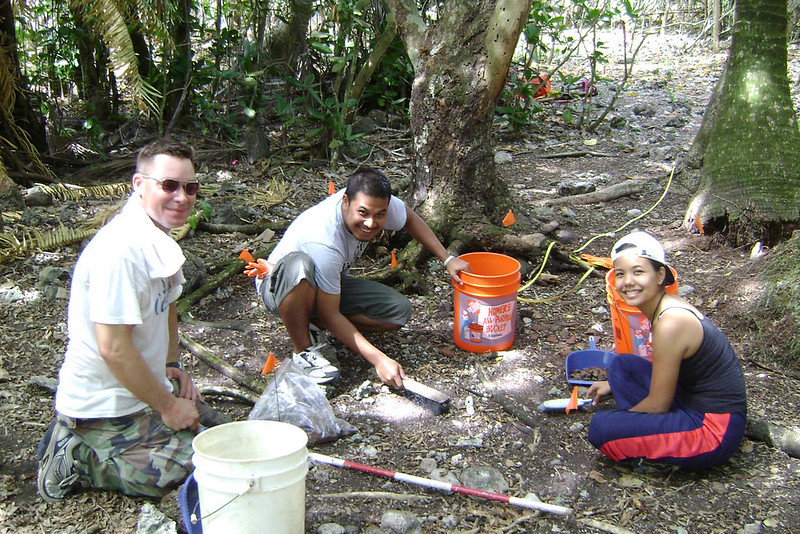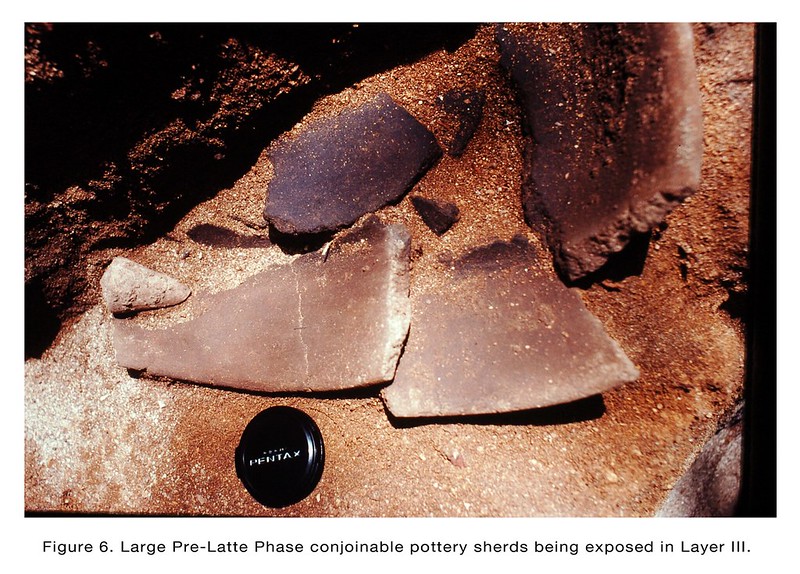Artifacts are clues to our ancient past
Guampedia, the Richard F. Taitano Micronesian Area Research Center University of Guam, and Guam Preservation Trust are pleased to collaborate on this collection of essays on archeological knowledge of the Marianas.
There has been a lot of archeological investigation in the Marianas. There are nearly a thousand archeological reports, but most of these were done to satisfy the historical preservation laws that require studies on many development projects. The sheer number of these is impressive, but in themselves they are not accessible or meaningful to the general reader. They are often more about the law or the specific development than they are about the general knowledge of archeology.
There are very few books that address Mariana Islands archeology. The best overviews are found in books about CHamoru history such as Scott Russell’s Tiempon I Manmofo’na: Ancient Chamorro Culture and History of the Northern Mariana Islands and Larry Cunningham’s Ancient Chamorro Society. These authors would be the first to say that there might be disagreements about some of the facts and the knowledge that they present, and would encourage the reader to be critical.
The following essays, then, mean to update these earlier studies and distill the present state of archeological knowledge from the mass of previous work. They are written by archeologists and anthropologists who are currently working on Guam or have worked previously on archeology projects in Guam and the Marianas, and who are aware of the latest discoveries and theories. They don’t all agree with each other, but the disagreements are based on their interpretations of the same facts that they all can see or read. Sometimes new facts or new ways of seeing will change the fundamental interpretations of Guam archeology. In this regard, archeology is a science that proceeds by testing new facts and ideas against our previous understanding.
Click here to see the Guampedia list of entries about Ancient Guam based on archeological investigations. Click here to see the Guampedia list of entries based on early historic accounts.
Themes describe ancient life ways
The following themes were selected in order to focus on general topics with present-day relevance. What was the ancient CHamoru like? What were the foods, the housing, the way that villages were organized and constructed? Were ancient CHamorus warlike or peaceful and cooperative? Where did they come from? How did the environment change and how did they adapt to the changing environment? Many of these topics are not clearly understood, but there are theories and concepts based on the present knowledge from the material culture.
The archeologist works with real things that were discarded or decayed from the time that previous people were living, eating, fishing, sailing, loving, and fighting; making tools and ornaments, protecting their families, exploring new places in the surrounding ocean. The stone haligi and tasa of latte houses and how they were arranged in the landscape can tell us much about social organization and the daily habits of the people. The remains of their tools and jewelry, ranging from slingstones to the broken pottery that they left behind can tell us how people lived and what they thought about the world around them, and how they viewed their place in the world. Many of the artifacts can tell us when people lived since previous archeological projects have found them and in association with materials such as charcoal that could be dated.
The context of archeological features and artifacts and the landscape surrounding them is the raw material that archeologists need to view, in place, without being disturbed, in order to discern the patterns that previous people left behind. Disturbing the context of an archeological site destroys the patterning and the ability to analyze and discover new truths. Historical preservation laws seek to preserve and protect archeological sites so they can give up their clues to ancient life ways to the discerning eyes of archeologists who are trained to peel back the layers of the past. Please respect and protect these ancient sites so that their wisdom can be preserved and passed along to future generations.
Archeological studies of the Marianas
The first archeologists to study and report on the ancient cultures of Guam were keen observers who kept excellent records of their findings. Alfred Marche was commissioned by the Paris Museum in the 1880s to make observations on the natural history and culture of Guam and the Marianas. Archeology was in its infancy at this time, but Marche made many astute descriptions of human remains and tools in caves, as well descriptions and photographic records of latte sites on Guam and the islands of Tinian and Saipan just north of Guam. He also visited the northernmost islands of the Marianas archipelago.
William Safford, a young US Naval officer assigned to the office of the Territorial Governor of Guam in 1902, was probably the first to make detailed observations that bore on the antiquities of the island. Safford, who was knowledgeable and learned about a variety of subjects, studied plants, geology, customs, and animals, as well as ancient sites on Guam. He commented on the material culture, language, customs and origins based on historical accounts and his own observations. His publications about Guam included Guam and Its People (1903), Useful Plants of Guam (1905), The Chamorro Language of Guam (1909), A Year on the Island of Guam: An Account of the First American Administration (1910), and Guam: An Account of its discovery, reduction, physical geography and natural history, and the social and economic conditions on the island during the first year of the American Occupation (1912).
Hans G. Hornbostel collected material over a six year period in the 1920s, and, from site recording and excavations, eventually contributed more than 9,000 specimens of monuments, potsherds, stone implements, and skeletal remains, as well as a collection of CHamoru texts with translations, lists of CHamoru family and place names, field notes on excavation, maps and photographs. His work has been unequaled in quality and detail, even though he was an untrained and avocational archeologist.
Laura Maud Thompson, an American anthropologist employed by the Bishop Museum in Honolulu, later compiled his notes and collections in the volume, Archeology of the Marianas Islands, which was published in 1932 and was the first definitive volume on Guam and Marianas archeology.
In the 1950s following World War II, US archeologists visited the islands and conducted survey and minor excavation projects. Erik Reed made a survey and documented latte villages and Spanish period sites for the US National Park Service; Douglas Osborne, who was on Guam from 1945-1947, also had conducted a survey, but his work in the region focused mainly on Palau. Later, in the early 1970s Fred Reinman’s work documented dozens of latte villages in Guam in what was, up to that time, the most systematic and thorough island-wide survey of archeological sites on Guam. Clement Meighan from University of California Los Angeles also conducted a survey where he revisited sites described by Reinman.
Reinman trained the first generation of CHamoru archeologists, Al Lizama among them, and several are still contributing to historic preservation on Guam. The work of John Craib at the Pagat site in northeast Guam, as well as at the Mochong site in Rota, laid the standard for future excavation projects and documented the condition of relatively undisturbed sites.
How archeology works
Archeologists construct cultural chronologies from their knowledge gained in survey and excavation. A chronology describes a culture in a particular moment in history, as well as shows how that culture changes over time. Early archeological studies on Guam reveal several different periods in Guam history based mostly on the presence of particular kinds of pottery and settlement architecture.
The obvious periods of Guam’s settlement were first described by Safford, Hornbostel, and Alexander Spoehr, who in the early 1950s, identified the age of settlement periods from radiocarbon dates on charcoal from his excavation of the Chalan Piao site in Tinian. Spoehr was first affiliated with the Field Museum in Chicago, but moved to the Bishop Museum in Honolulu. In addition to radiocarbon dating of charcoal, archeologists have used pottery styles associated with the dated stratigraphy to identify different periods when they are found elsewhere. Stratigraphy refers to the study of layers (strata) of rock or soil deposits in an archeological excavation site. The older layers are generally deeper in the site while younger layers are located more closely to the surface.
The earliest pottery was a thin red-slipped variety with punctate (having tiny spots, dots or points) impressions decorating the outside of the vessels. The vessels had flared rims above globular jar-shapes and bowls. Spoehr first found this type in his Chalan Piao excavations and called it Marianas redware. He also found similar samples in Zamboanga, Philippines, in a later excavation, and others have reported it from the Arnhem Peninsula in northern Australia. This redware pottery is very widespread in the period 3,500 to 4,000 years ago, and is found on Guam and in the Northern Marianas as early as 3,500 years ago.
By 1,800 to 2,200 years ago another pottery style is found in sites dated from that period. These vessels were flat-bottomed, thick pans with straight walls and rims and were often decorated with the impressions of woven matting on the base. Thin-walled black and also reddish pottery are found during this period, but few sites have been found and documented.
The biggest and best preserved site was excavated just seaward from Pale San Vitores Road in the coastal village of Tumon, Guam, near the Guam Police Substation, in 2008. The site was also important for the paleoenviromental information that it provided. (Paleoenvironmental describes the past environment and climate of a place in a particular time period.) Numerous rock ovens were found with broken pottery sherds, while pollen, phytolith (the microscopic silica bodies found in many plants) and starch residue studies reported breadfruit, taro, and other plant remains; faunal studies found considerable fish bone from a variety of both reef and off-shore fishes. These studies suggest that the pan pottery may have been baking dishes for breadfruit as has been observed in some recent ethnographic settings in the region.
This site would have been on the backdune (or backside of the shoreline that angles away from the ocean) at that period of time, as the sea level had just dropped over a meter from its highest levels of 1.8 – 2.0 meters higher in the period from 5,500 to 3,000 years ago; about 2,000 years ago it dropped another meter to its present elevation. Indeed, with continuing climate change and global warming, sea levels are expected to rise to those levels again within the next several decades.
A new style of pottery emerged around AD 900, accompanied soon after by the distinctive and endemic latte architecture. Designated Latte Era pottery, the ceramics of this period apparently are unique to Guam and the Marianas. They are characterized as “B-Rim” vessels with their incurved, thickened rims, but there is also a thin-walled type. Starch residue from taro has been found on “B-Rim” vessels.
In addition to changes in pottery, changes were also made to residences and other structures in this period. There is evidence that houses were built on stilts in earlier periods and throughout the Latte Era. Sites from this period are found throughout Guam in both coastal and interior areas, often along rivers, and latte houses–with their parallel rows of stone posts (haligi) and caps (tasa)–may have had various uses from residences to canoe sheds to men’s houses.
Although not fully substantiated, the latte style quite possibly is uniquely CHamoru. Although there are examples in Indonesia that seem to display architecture similar to latte, just like stone money for Yap and the stone monuments of Pohnpei and Kosrae, latte architecture is recognized as a local cultural practice.
Another cultural feature of this era is the hybridization of breadfruit from Artocarpus altilis and A. camansi with A. mariannensis from Guam and the Marianas. The result was a breadfruit that was salt-tolerant, seedless, and ripened throughout the year. This hybrid was critical for survival in the low-lying atolls and dispersed islands of Micronesia where extreme weather often disrupted productivity.
Also, the distinctive Austronesian matrifocal, matrilineal social organization provided a resilient practice for homesteading these islands by reducing competition among the male voyagers and ensuring a stable home unit. This region includes the islands of the South Pacific–Polynesia, Melanesia and Micronesia–as well as parts of Southeast Asia, Taiwan and Madagascar. Matrifocal, matrilineal social organizations are societies whereby inheritance and access to social rankings, lineages or resources are derived from the mother’s side. Many of the cultures in Micronesia, including CHamoru culture, are matrilineal.
Contact with Europeans
Contact with European culture began with Ferdinand Magellan and his hapless crew who drifted into Guam in 1521, but except for sporadic visits, there was no serious interaction until 1672 when Jesuit missionaries seriously undertook settlement, reducción, and domination of the islands. The reducción was a Spanish colonial policy meant to centralize the dispersed populations of the Marianas through the forced removal of CHamoru natives from their home islands and their re-settlement into villages on Guam and Rota.
By the 1690s they had successfully resettled the CHamorus from dispersed latte villages into centers of residence in Hagåtña, Agat, Humåtak, Merizo, Inarajan, and Pago villages. In the 18th century the Jesuit missionaries developed haciendas or estates throughout central and southern Guam that produced cattle, horses, corn, as well as native CHamoru foods. These became Royal haciendas in 1769 when the Jesuits were dispelled from Guam and replaced with Spanish Augustinian Recollect priests. Although these hacienda sites have not been preserved, they have potential as a core for historical landscape preservation in southern Guam.
Spanish period archeology is best demonstrated by the Plaza de España Governor’s House project conducted in 1981 in Hagåtña, Guam. The structures and the European grid plan were well-documented during this project, which was one of the earliest systematic, inter-disciplinary excavations in Guam. Probes beneath the footprint of the Governor’s House documented Latte Period and even very early pre-Latte strata with red-slipped pottery at the lowest levels, but they were not extensively documented.
National Historic Preservation Act
In the 1980s a new generation of academic and contract archeologists emerged in Guam as elsewhere in the United States. The National Historic Preservation Act of 1966 provided a regulatory framework for protecting and preserving historical and archeological sites. After a few years of experimentation, the Section 106 regulations of the Act were finally implemented nationwide. Historic preservation offices in Guam and the rest of the Micronesian island groups were established and local codes were instituted to assist in the protection and management of sites.
In the early 1980s practicum archeology was spearheaded by the Micronesian Area Research Center (MARC), under the direction of Hiro Kurashina. Projects at Tarague Bay and Ritidian Point along the northern coast of Guam were systematic, inter-disciplinary projects that provided comprehensive site documentation and historical contexts for the evaluation and preservation of these sites and landscapes. Work at Tarague Bay documented the earliest settlement on Guam, in the era around 3,400 years ago. The project also described the geological context of the settlement that was found to be stratigraphically immediately above the level of the 5,000 year old fossil reef layer identified as “Merizo limestone.”
Richard Randall provided the first geological context for archeological studies on Guam through his work on these projects. Other young archeologists were trained as well, including Darlene Moore who was the first to comprehensively describe and document the ceramic typology for Guam and the Marianas. Current projects by MARC at Ritidian have documented the Casa Real (a Jesuit settlement at Ritidian) from the early period of Jesuit missionary work, and latte villages that were occupied concurrently with Spanish period incursions or attacks on the CHamorus during the CHamoru Spanish Wars in the late 17th century. Apparently the transition from Latte “period” was not instantaneous, at least not until the Spanish had enforced the reducción and outlawed the guma‘ uritao, (CHamoru bachelor houses).
Several private consulting firms set up shop on Guam beginning in the 1980s, and much of the effort was funded by the US Navy, the US Air Force, and the National Park Service on federal lands. The development of hotel properties in Tumon Bay supported an explosion of contract archeology projects that documented the Latte Period settlement of the bay. A few projects contributed data on earlier periods of settlement, for example, in Ypao Beach and in the area of the Hyatt and Sand Castle, all in Tumon. Large projects for golf courses such as in the central village of Mangilao and the Manenggon Hills in Yona contributed data on upland sites.
Research themes broadened from classificatory, descriptive and typological studies to include environmental considerations. Work by J. Stephen Athens and Jerome Ward at a US Navy project along the Sasa River (located between Piti and Naval Station) led to a description and dating of a deep core sample. Athens described the sediments and obtained radiocarbon ages, while Ward’s pollen analysis provided data to interpret paleoenvironments during these earlier dated contexts. Using a technique of linear correlation, Athens argued that the sudden appearance of charcoal in what he identified as 4,000 year old deposits suggested people may have come to Guam earlier than 3,500 years as previously documented.
Athens presumed that charcoal indicated that people had arrived and were burning forests to prepare housing sites and for swidden farming. Swidden farming, also known as shifting cultivation and sometimes as slash-and-burn farming, involves clearing of land by cutting down and burning of vegetation prior to the rainy season to enhance the soil for farming.
Rosalind Hunter-Anderson, an archeologist with Micronesian Archeological Research Services (MARS), argued that the charcoal actually was evidence of early fires and natural maintenance of savannah environments in Guam, similar to the southern hills of Guam today. However, there is no evidence for any earlier charcoal, which one might expect if the fires on the savannahs were a natural occurrence, and the earliest dated sediments in the core were thousands of years earlier. Furthermore, there was evidence from the pollen that typical tropical forest species were abundant prior to the charcoal, which is expected given the dominant and prevailing natural vegetation patterns in the region.
On the other hand, Athen’s use of linear correlation misrepresents the age of charcoal in the core. Sediments between the bracketing dates of 4,500 years and 2,800 years do not necessarily gradually accumulate, and in fact, deposition of soil alternating with periods of erosion are common and more likely. Therefore dating the first human settlement, around 3,500 years ago, is more reasonable given all the evidence and some that has been acquired since Athen’s pioneering study.
Landscape studies emerge
Landscape studies are the focus of the present generation’s archeological investigations in the region. Use of Geographic Information System (GIS) software has revolutionized site documentation as well as analytical and management approaches in archeology. Environmental processes such as the rise of sea level or other changes in climate can be modeled using GIS mapping. Paleoenvironmental change can be seen in many settings on Guam such as the emergence of the Hagåtña marsh and the meanders of the Hagåtña River, the shoreline buildup at Tumon Bay and Ritidian Point, and farming landscapes such as the gadda’o or spiny yam fields in the southern highlands, which Darlene Moore first described.
These farming landscapes are currently the subject of research, especially as they relate to human settlement. Recent work in Pago Bay by MARS and MARC archeologists have documented the Spanish period Pago Village, as well as gadda’o fields at the base of the steep Yona cliffline. This, along with evidence of breadfruit and taro found in the soils of the lower Pago River floodplain, suggest agroforestry complexes in the village catchments (areas where people could gather resources for daily living). Supplemented with protein from ocean fisheries such as in Pago Bay on Guam, as well as offshore throughout the Marianas, the indigenous CHamoru clearly had a thrifty and vibrant cultural lifeway in these islands.
The future of archeology in the Marianas
The demands of the current economic buildup on Guam challenge us to rethink the archeological and historical past, and to be innovative in our efforts at historic preservation. Preserving and protecting archeological sites is important, but preserving landscapes contributes to scenic views like the mountains of southern Guam and the World War II battlefield sites of Asan and Agat, which are of particular scenic and historic value.
Preservation of urban districts with zoning controls nudges development toward protection and restoration of historical structures as well as ensuring compatible buildings and infrastructure. Zoning controls should be legislated and enforced to limit urban sprawl and protect open space, visions of historical and natural views, and cultural landscapes where CHamoru identity and cultural practice such as medicinal plant gathering can be maintained.
Each era of archeological research has its own worldview and biases. Over the past hundred years investigations have grown from descriptive to scientific, with each generation imparting a sense of the significance of places of the past, imbued with a sense of reverence for islander lifeways and identity.
For further reading
Athens, J. Stephen, and Jerome V. Ward. “Holocene Vegetation, Savanna Origins and Human Settlement of Guam.” Records of the Australian Museum, Supplement 29, no. 1 (2004): 15-30.
Carson, Mike T., ed. “Archaeological Studies of the Latte Period.” Micronesica 42, no. 1/2 (2012): 1-79.
Craib, John L. “Casas de los Antiguos: Social Differentiation in Protohistoric Chamorro Society, Mariana Islands, Micronesia.” PhD diss., University of Sydney, 1986.
Hunter-Anderson, Rosalind L. “Savanna Anthropogenesis in the Mariana Islands, Micronesia: Re-interpreting the Palaeoenvironmental Data.” Archaeology in Oceania 44, no. 3 (2009): 125-141.
Marche, Antoine-Alfred. The Mariana Islands. Translated by Sylvia E. Cheng and edited by Robert D. Craig. Mangilao: Richard F. Taitano Micronesian Area Research Center, University of Guam, 1982.
Moore, Darlene R. “Archaeological Evidence of a Prehistoric Farming Technique on Guam.” Micronesica 38, no. 1 (2005): 93-120.
Osborne, Douglas. “Archaeology on Guam: A Progress Report.” American Anthropologist 49, no. 3 (1947): 518-524.
Petersen, Glenn. Traditional Micronesian Societies: Adaptation, Integration, and Political Organization. Honolulu: University of Hawai’i Press, 2009.
Reinman, Fred. Notes on an Archaeological Survey of Guam, Mariana Islands, 1965-1966. Mangilao: Micronesian Area Research Center, University of Guam, 1977.
Safford, William E. The Useful Plants of the Island of Guam. Washington, DC: Government Printing Office, 1905.
Schuetz, Mardith K. The Archaeology of the Governor’s Palace: Plaza de Espana, Agana, Guam. Mangilao: University of Guam Richard F. Taitano Micronesian Area Research Center, 2007.
Spoehr, Alexander. Marianas Prehistory: Archaeological Survey and Excavations on Saipan, Tinian and Rota. Fieldiana: Anthropology. Vol. 48. Chicago: Chicago Natural History Museum, 1957.
Thompson, Laura M. Archaeology of the Mariana Islands. Bernice P. Bishop Museum Bulletin, No. 100. Honolulu: Bishop Museum Press, 1932.
US Department of the Interior National Park Service. General Report on Archeology and History of Guam. By Erik K. Reed. Sante Fe: NPS, 1952.
Archeological Investigations
- Ancient CHamoru Agricultural Practices
- Ancient CHamoru Body Modification
- Ancient CHamoru Burial Practices
- Ancient CHamoru Burial Rituals
- Ancient CHamoru Cave Art
- Ancient CHamoru Concepts of Beauty
- Ancient CHamoru Cultural Aspects of Fishing
- Ancient CHamoru Fish Weirs (Gigao)
- Ancient CHamoru Fishing Practices
- Ancient CHamoru Fishing Tools
- Ancient CHamoru Food and Diet
- Ancient CHamoru Jewelry: Manmade Accessories and Body Coverings
- Ancient CHamoru Kinship and Land Tenure
- Ancient CHamoru Medicine Making
- Ancient CHamoru Pottery Usage
- Ancient CHamoru Pottery: Early Calcareous Ware
- Ancient CHamoru Settlement Patterns
- Ancient CHamoru Tool Making
- Ancient CHamoru Use of Human Bones
- Ancient CHamoru Use of Rice
- Ancient CHamoru Warfare
- Ancient Guam’s Environment
- Ancient Village: Pågat
- Ancient Village: Pago (Pågu)
- Ancient Village: Ritidian (Litekyan)
- Ancient Village: Tarague (Talågi)
- Cultural Aspects of Ancient CHamoru Warfare

